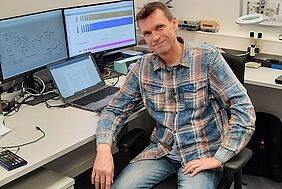Electronics are found in most of the cutting-edge products we live and work with. So it makes sense that seasoned experts like Thomas Dworeck are always working on the further development and improvement of technologies. Learn in the interview what shaped Thomas’ work life in particular and how he is advancing technology at Rethink Robotics today.
Hello Thomas! Thank you for telling us a little bit about your work at Rethink Robotics today. But first, let's take a step back: What shaped your career before you joined us?
My life has always been closely intertwined with technology. At first I started experimenting with Lego and when I was 12/13 years old I started working on electronics and experiment kits. I was excited to work on things by myself because I have a very strong sense for design and development.
In my youth, this led to a classic apprenticeship as an electronics technician and I quickly became a trainer for the fields of digital and computer technology.
For about 15 years I was also active as a service technician. I was out and about a lot and dealt with the support for electronic devices, which was also a lot of fun. Nevertheless, in this job I felt a lack of creativity and experimentation.
After my venture in service, I tried several positions in where I got to work with research and development, which exactly matched my interest profile. Recently, however, I was frustrated that I was too often alone as an expert in the company and therefore had no one with whom I could properly exchange ideas about my work.
What brought you to Rethink Robotics?
Actually, I discovered the company quite by accident on Xing, because they were looking for employees in the robotics sector. However, there was no information about the company location. Because the public transport connection is very important to me when deciding on a job, I wrote an application to find out. A few days later, CEO Daniel Bunse called me personally and explained that the company was just starting up and that some things were still changing. Based on my career, Daniel saw me more as an electrical design engineer, although with my professional experience I could of course shape the position myself and find my role in it.
And what convinced you after this adventurous application process to work for Rethink Robotics?
It is very important to me that I now get to work with people who are very interested in the technology. This enables us to establish a closer relationship with our colleagues. I'm currently the oldest in the team, but it isn’t really noticeable or makes any kind of difference. After all, we all have a very young and dynamic way of striving forward, with a lot of enthusiasm for what we can still do and research in order to bring the product and the company forward together. I feel in the right place here and I'm excited to see how things will continue.
What is it that particularly appeals to you about robots?
Robotics are, so to speak, a “high-end” product, because of the complex interplay of electronics, software and mechanics. I am simply enthusiastic about this technology and I notice that I can still learn a lot and get involved.
What are you working on now exactly?
I am currently familiarizing myself with the topics of electronics and embedded software in order to learn how our cobot models work exactly and where possible weak points could be. To put it simply, I work on the circuit boards that are built into robots.
Because a lot of development takes place in our partner companies I also could not arrive and immediately start my own project. A large part of my job will probably involve quality assurance, because cobots have to be particularly reliable due to their proximity to people. We have to keep in mind that people are more important than any robot. Technology is there to make work and life easier for people.
What is the biggest challenge in your field?
Several areas of responsibility overlap with me. At one end are the electronics, at the other the user interface. Here, the transition, i.e. the interfaces, need to be managed well. This is especially important for people who are already specialized in different subject areas. You need to have good relationships within the team to work your way through this together.
You too have to be able to reflect in order to anticipate complex situations or to recognize which complex processes have to be coordinated within the robot. Many technical areas work closely together here, for example when certain components or software codes are used. All of this has to be taken into account in order to end up with a good product, but the software in particular has a strong influence.
Where do you see the biggest trends in the industry?
Sensor technology will still do a lot in robotics, because it will make the observation of the environment more intelligent. This means that physical contact does not have to take place when the robot can already detect and avoid impending collisions through optical monitoring. The combination with mobile robots also allows greater freedom of movement for cobots and enables automated and smooth change of location within the company or a work process.
Overall, there is still a lot of leeway in medium-sized companies to establish cobots. For example, sorting tasks are not very interesting for people. If you hand this task over to a cobot, then the employees can devote themselves to more demanding tasks. Such potentials are certainly not yet fully explored.

